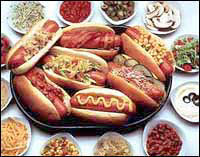Hot Dog History
In honor of National Hot Dog Month, some answers to those dogging questions
July is National Hot Dog Month, and according to the National Hot Dog and Sausage Council, Americans will be consuming the infamous little red tubes of "meat" in record numbers this summer.
The Council estimates that over seven billion hot dogs will be eaten by Americans between Memorial Day and Labor Day. During the July 4th weekend alone (the biggest hot-dog holiday of the year), 155 million will be downed.
Every year, Americans eat an average of 60 hot dogs each. They are clearly one of the country's most loved, but most misunderstood, comfort foods. Below you'll find some frequently asked questions regarding the hot dog. For more information, visit the Council's website at www.hot-dog.org. Bon appétit.
How did the hot dog get its name?
The term "hot dog" is credited to sports cartoonist Tad Dorgan. At a 1901 baseball game at the Polo Grounds in New York, vendors began selling hot dachsund sausages in rolls.

Remember: the condiment of choice is mustard. (Source/Nat'l Hot Dog Council) |
From the press box, Dorgan could hear the vendors yelling, "Get your dachshund sausages while they're red hot!" He sketched a cartoon depicting the scene but wasn't sure how to spell "dachshund" so he called them simply, "hot dogs." And the rest is history.
What exactly is a hot dog made of?
Nope. You're not allowed to ask that one. And do you really want to know anyway? For the record, the Council refers to the actual meat as "specially selected meat trimmings." They would like to point out, however, that thanks to stricter U.S.
Department of Agriculture rules, hot-dog meat has become much leaner and, unless otherwise indicated, must be made from muscle (as most meat found in supermarkets is).
Most supermarket hot dogs use cellulose casings, which are removed before packaging. Some, however, still use the traditional natural casings, made from animal intestines.
![]()
During the July 4th weekend, Americans will consume 155 million hot dogs. (Source/National Hot Dog and Sausage Council) |
By law, a hot dog can contain up to 3.5 percent of "non-meat ingredients." Don't be scared. This is usually just some type of
milk or soy product used to add to the
nutritional value. Many hot dogs may be relatively high in fat and sodium, but they are also a good source of protein, iron, and other necessary vitamins.
What is the most popular condiment for a hot dog?
Council research shows that for adults,
mustard is the condiment of choice, while children prefer
ketchup. That said, preferences do change from region to region. For instance, hot dogs in
New York are generally served with a lighter mustard and steamed onions, while Chicago hot dogs can come with mustard, relish, onions, tomato slices, or pretty much anything at all.
Kids were also asked what condiment they would use "if their moms weren't watching," and 25 percent opted for
chocolate sauce.
Do I spread my condiment on the meat or on the bread?
Always dress the dog and not the bun. The Council also recommends the following order for condiment application: first wet (mustard for example), then chunky (relish or onions), then cheese if desired, then any spices.
What should I drink with my hot dog?
Lemonade and iced tea—the tastiest drinks for a summer barbecue—are perfect with hot dogs.



